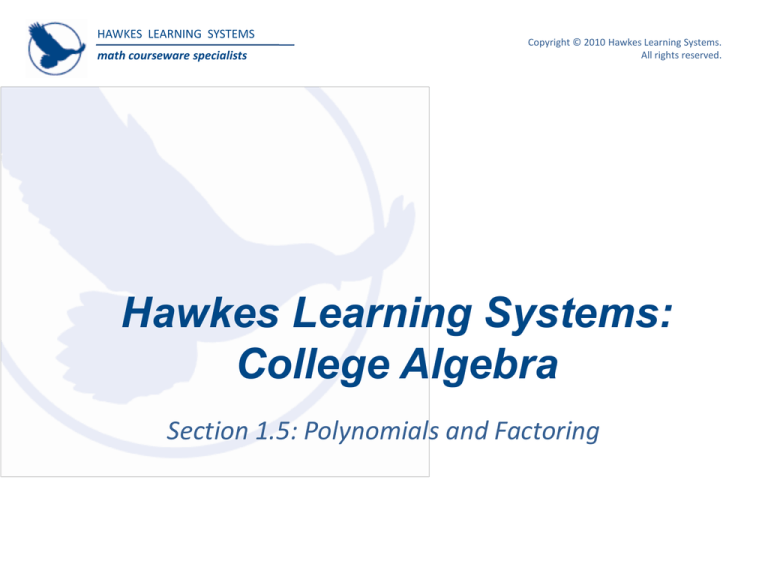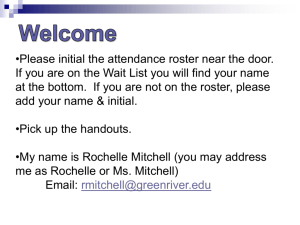
HAWKES LEARNING SYSTEMS
math courseware specialists
Copyright © 2010 Hawkes Learning Systems.
All rights reserved.
Hawkes Learning Systems:
College Algebra
Section 1.5: Polynomials and Factoring
HAWKES LEARNING SYSTEMS
Copyright © 2010 Hawkes Learning Systems.
All rights reserved.
math courseware specialists
Objectives:
o The terminology of polynomial expressions
o The algebra of polynomials
o Common factoring methods
HAWKES LEARNING SYSTEMS
math courseware specialists
Copyright © 2010 Hawkes Learning Systems.
All rights reserved.
The Terminology of Polynomial Expressions
o Coefficient: A number multiplied by a variable in any
of the terms of a polynomial.
o Degree of the term: The sum of the exponents of the
variables in that term.
o Constant term: Any non-zero number that is not
multiplied by a variable.
Note: Constant terms have a degree of zero.
o Degree of a polynomial: The largest degree of all the
individual terms.
HAWKES LEARNING SYSTEMS
math courseware specialists
Copyright © 2010 Hawkes Learning Systems.
All rights reserved.
The Terminology of Polynomial Expressions
o Monomials: Polynomials consisting of a single term
2
17
x
, 5 xy, 3
Ex:
o Binomials: Polynomials consisting of two terms
Ex: 25 x 2 2, 16 x 1
o Trinomials: Polynomials consisting of three terms
Ex: 37 xy 2 4 x 2, 16 y 2 11xy 13
HAWKES LEARNING SYSTEMS
Copyright © 2010 Hawkes Learning Systems.
All rights reserved.
math courseware specialists
Example: The Terminology of Polynomial
Expressions
Expression
2 3 5
x y y10 3
3
Terms
3
Type
Trinomial
Degree
Explanation
10
The degree of the first
term is 8, the degree of
the second term is 10,
and the degree of the
third term is 0.
3x 4 y 2 5.4 x3 y 4
2
Binomial
7
The degree of the first
term is 6 and the
degree of the second
term is 7.
5
1
Monomial
0
The degree of a
constant is always 0.
HAWKES LEARNING SYSTEMS
math courseware specialists
Copyright © 2010 Hawkes Learning Systems.
All rights reserved.
Polynomials of a Single Variable
Polynomials of a Single Variable
A polynomial in the variable of a degree n can be
written in the form
an x n an1 x n1 ... a1 x a0
where an , an1 ,..., a1 , a0 are real numbers, an 0 and n
is a positive integer. This form is called
descending order because the powers descend
from left to right. The leading coefficient of this
polynomial is an .
HAWKES LEARNING SYSTEMS
math courseware specialists
Copyright © 2010 Hawkes Learning Systems.
All rights reserved.
Example: Descending Order
Write the polynomial in descending order. State the
degree of the polynomial and the leading coefficient.
4 – 2x5 + x2
HAWKES LEARNING SYSTEMS
Copyright © 2010 Hawkes Learning Systems.
All rights reserved.
math courseware specialists
The Algebra of Polynomials
Like or similar terms: The terms among all the
polynomials being added that have the same
variables raised to the same powers.
Ex: What are the like terms in the polynomial below?
x 2 z y z y 3x
3
2
2
3
x3 2 z y 2 z y 2 3x3
x3 and 3x3 , 2 z and z, y 2 and
3
3
Notice that x and 3x both
include the variable x
raised to the third power.
These are like or similar
terms. Can you find any
y 2 others?
HAWKES LEARNING SYSTEMS
math courseware specialists
Copyright © 2010 Hawkes Learning Systems.
All rights reserved.
Example: Algebra of Polynomials
a) Subtract the Polynomials.
(x4 + 2x3 – x + 5) – (x3 – x – x4)
b) Multiply the Polynomials.
(x2 – 2y)(x2 + y)
HAWKES LEARNING SYSTEMS
Copyright © 2010 Hawkes Learning Systems.
All rights reserved.
math courseware specialists
The Algebra of Polynomials
When a binomial is multiplied by a binomial, the
acronym FOIL is commonly used as a reminder of the
four necessary products. Consider the product:
First
Outer
(3ab a 2 )(ab a 2 )
Inner
Last
The solution to the product above would be
First + Outer + Inner + Last
HAWKES LEARNING SYSTEMS
Copyright © 2010 Hawkes Learning Systems.
All rights reserved.
math courseware specialists
The Algebra of Polynomials
Consider the product:
(3ab a 2 )(ab a 2 )
3a 2b 2
3
3a
b
The product of the Outer terms is
The product of the First terms is
The product of the Inner Terms is a 3b
The product of the Last terms is
a 4
So, First + Outer + Inner + Last = 3a 2b 2+ 3a 3b a 3ba 4
= 3a2b2 + 2a3b – a4
HAWKES LEARNING SYSTEMS
math courseware specialists
Copyright © 2010 Hawkes Learning Systems.
All rights reserved.
Common Factoring Methods: Terminology
o Factoring: Reversing the process of multiplication in
order to find two or more expressions whose
product is the original expression.
o Factorable: A polynomial with integer coefficients is
factorable if it can be written as a product of two or
more polynomials, all of which also have integer
coefficients.
o Irreducible (over the integers) or prime: A
polynomial that is not factorable.
o Completely Factor: To write a polynomial as a
product of prime polynomials.
HAWKES LEARNING SYSTEMS
math courseware specialists
Copyright © 2010 Hawkes Learning Systems.
All rights reserved.
Common Factoring Methods
o Method 1: Greatest common factor.
o Method 2: Factoring by grouping.
o Method 3: Factoring special binomials.
o Method 4: Factoring trinomials.
o
Case 1: Leading coefficient is 1.
o
Case 2: Leading coefficient is not 1.
o Method 5: Factoring Expressions Containing
Fractional or Negative Exponents
HAWKES LEARNING SYSTEMS
math courseware specialists
Copyright © 2010 Hawkes Learning Systems.
All rights reserved.
Common Factoring Methods: Method 1
Method 1: Greatest Common Factor
The Greatest Common Factor (GCF) among all the terms is
simply the product of all the factors common to each. The
Greatest Common Factor method is a matter of applying the
distributive property to “un-distribute” the greatest common
factor.
Find the greatest common factor of 12 x 4 y 2 8 x3 y 2 4 x3 y
3
GCF: 4x y
What do the three terms in the polynomial have in
3
common? 4, x , and y . The product of these terms
is the GCF of the polynomial.
So,12 x 4 y 2 8 x3 y 2 4 x3 y 4 x3 y 3xy 2 y 1
HAWKES LEARNING SYSTEMS
math courseware specialists
Copyright © 2010 Hawkes Learning Systems.
All rights reserved.
Common Factoring Methods: Method 2
Method 2: Factoring by Grouping.
Factoring by Grouping: A trial and error process
applied when the first factoring method is not
directly applicable. If the terms of the polynomial
are grouped in a suitable way, the GCF method may
apply to each group, and a common factor might
subsequently be found among the groups.
HAWKES LEARNING SYSTEMS
math courseware specialists
Copyright © 2010 Hawkes Learning Systems.
All rights reserved.
Example: Factoring by Grouping.
Factor by Grouping.
ax – 2bx – 2ay + 4by
HAWKES LEARNING SYSTEMS
math courseware specialists
Copyright © 2010 Hawkes Learning Systems.
All rights reserved.
Common Factoring Methods
Method 3: Factoring Special Binomials
Three types of binomials can always be factored following
certain patterns. In the following, A and B represent algebraic
expressions.
o Difference of Two Squares:
A2 B 2 ( A B)( A B)
o Difference of Two Cubes:
A3 B3 ( A B)( A2 AB B 2 )
o Sum of Two Cubes:
A3 B3 ( A B)( A2 AB B 2 )
HAWKES LEARNING SYSTEMS
math courseware specialists
Copyright © 2010 Hawkes Learning Systems.
All rights reserved.
Example: Factoring Special Binomials
Factor the Special Binomials. A2 B 2 ( A B)( A B)
a) 49a2 – 144b2
A3 B3 ( A B)( A2 AB B 2 )
A3 B3 ( A B)( A2 AB B 2 )
b) x3 – 27y3
c) m6 + 125n9
HAWKES LEARNING SYSTEMS
math courseware specialists
Copyright © 2010 Hawkes Learning Systems.
All rights reserved.
Common Factoring Methods
Method 4, Case 1: Leading Coefficient is 1.
In this case, we only need q and s such that
x 2 bx c x 2 (q s ) x qs = (x + q)(x + s)
That is, we need two integers whose sum is b, the
coefficient of x, and whose product is c, the constant
term.
Consider (x + 7)(x + 2) =
HAWKES LEARNING SYSTEMS
math courseware specialists
Copyright © 2010 Hawkes Learning Systems.
All rights reserved.
Common Factoring Methods
Use Method 4, Case 1 to factor the following polynomial.
Ex:
o Factor: x 2 3 x 2
o Begin by writing x 2 3x 2 x ? x ? .
o We need to find two integers to replace the question
marks. The two integers we seek must have a product of 2.
Because the product is positive, both integers must be
either positive or negative. Therefore, the only possibilities
are 2,1 or 2, 1 .
o Additionally, the sum of these two integers must be 3.
Therefore, they must be 2,1 .
2
x
o Thus, 3x 2 ( x 2)( x 1).
HAWKES LEARNING SYSTEMS
math courseware specialists
Copyright © 2010 Hawkes Learning Systems.
All rights reserved.
Example: Factoring Trinomials
Factor the Trinomial.
a) x2 + 2x – 15
b) 6x2 + 5x – 6
HAWKES LEARNING SYSTEMS
math courseware specialists
Copyright © 2010 Hawkes Learning Systems.
All rights reserved.
Common Factoring Methods
Method 4, Case 2: Leading Coefficient is not 1.
Factoring Trinomials by Grouping
For the trinomial ax 2 bx c :
Step 1: Multiply a and c.
Step 2: Factor ac into two integers whose sum is b. If
no such factors exist, the trinomial is irreducible over
the integers.
Step 3: Rewrite b in the trinomial with the two
integers found in step 2. The resulting polynomial of
four terms may now be factored by grouping.
HAWKES LEARNING SYSTEMS
Copyright © 2010 Hawkes Learning Systems.
All rights reserved.
math courseware specialists
Example: Common Factoring Methods
Factor the following trinomial by grouping:
6 x 2 x 12
1. (6)(12) 72
Multiply a and c.
2. 9 and 8
Factor ac into two integers whose sum is
b.
2
6
x
9 x 8 x 12
3.
Rewrite b in the trinomial with the
two integers found in step 2 and
distribute.
Group.
4. 3x(2 x 3) 4(2 x 3)
5. (2 x 3)(3 x 4)
HAWKES LEARNING SYSTEMS
math courseware specialists
Copyright © 2010 Hawkes Learning Systems.
All rights reserved.
Common Factoring Methods
Perfect Square Trinomials: trinomial expressions whose
factored form is the square of a binomial expression.
There are two forms of Perfect Square Trinomials:
A2 2 AB B 2 ( A B ) 2
A2 2 AB B 2 ( A B ) 2
HAWKES LEARNING SYSTEMS
math courseware specialists
Copyright © 2010 Hawkes Learning Systems.
All rights reserved.
Example: Perfect Square Trinomials
Factor the Trinomial.
y2 + 14y + 49
HAWKES LEARNING SYSTEMS
math courseware specialists
Copyright © 2010 Hawkes Learning Systems.
All rights reserved.
Common Factoring Methods: Method 5
Method 5: Factoring Expressions Containing
Fractional or Negative Exponents
To factor an algebraic expression that has fractional or
negative exponents, identify the least exponent among
the various terms and factor the variable raised to that
least exponent from each of the terms.
HAWKES LEARNING SYSTEMS
math courseware specialists
Copyright © 2010 Hawkes Learning Systems.
All rights reserved.
Example: Factoring with Negative
Exponents
Factor the algebraic expression.
7a-1 – 2a-3b






